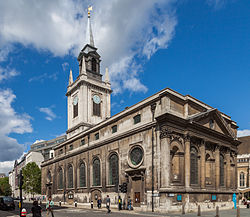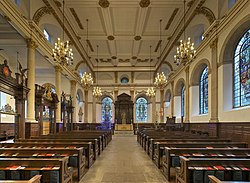St Lawrence Jewry
| St Lawrence Jewry | |
|
London, Middlesex | |
|---|---|
 St Lawrence Jewry from the south-east | |
| Church of England | |
| Diocese of London | |
| Location | |
| Location: | 51°30’55"N, 0°5’33"W |
| Address: | Gresham Street |
| History | |
| Baroque | |
| Information | |
| Website: | stlawrencejewry.org.uk |

St Lawrence Jewry next Guildhall is a Church of England guild church in the City of London, on Gresham Street, next to Guildhall. The church was destroyed in the Great Fire of London in 1666, and rebuilt to the designs of Sir Christopher Wren. It is the official church of the Lord Mayor of London.
It is designated a Grade I listed building.[1]
History
Middle Ages
The church was originally built in the twelfth century and dedicated to St Lawrence. The weather vane of the present church is in the form of his instrument of martyrdom, the gridiron.[2] The church is near the former mediæval Jewish quarter of the city,[3] which was centred on the street named Old Jewry.[4] From 1280, the advowson belonged to Balliol College, Oxford.
Sir Thomas More preached in the older church on this site.[5]
17th century
In 1618 the church was repaired, and all the windows filled with stained glass paid for by individual donors.[6]
The mediæval church was destroyed in the Great Fire of London[7] and rebuilt by Christopher Wren between 1670 and 1687.[8] The parish was united with that of St Mary Magdalen, Milk Street, which was not rebuilt.[6] The church is entirely faced in stone, with a grand east front, on which four attached Corinthian columns, raised on a basement, support a pediment placed against a high attic.[8] George Godwin, writing in 1839, described the details of this facade as displaying " a purity of feeling almost Grecian", while pointing out that Wren's pediment acts only as a superficial adornment to the wall, rather than, as in Classical architecture, forming an extension of the roof.[6]
Inside, Wren's church has an aisle on the north side only, divided from the nave by Corinthian columns, carrying an entablature that continues around the walls of the main body of the church, where it is supported on pilasters. The ceiling is divided into sunken panels, ornamented with wreaths and branches.[6] The church is 81 feet long and 68 feet wide.[9]

20th century
The church suffered extensive damage during the Blitz on 29 December 1940,[10] and after the war the City of London Corporation agreed to restore it as Balliol College had no funds to do so. It was restored in 1957 by Cecil Brown to Wren's original design. It is no longer a parish church but a guild church, and the advowson has been transferred to the City, of which it is now official church.
The church was described by Sir John Betjeman as "very municipal, very splendid."[11]
The church is used by the New Zealand Society UK, who celebrate Waitangi Day here in February each year.
Outside links
| ("Wikimedia Commons" has material about St Lawrence Jewry) |
- St Lawrence Jewry
- St Lawrence Jewry at London City Churches
References
- ↑ National Heritage List 1064673: Church of St Lawrence Jewry
- ↑ Bradley, Simon & Pevsner, Nikolaus. "London: the City Churches". New Haven: Yale University Press, 2002 ISBN 0-300-09655-0
- ↑ Hibbert, C; Weinreb, D.; Keay, J. "The London Encyclopaedia". London: Pan Macmillan, 1983 (rev 1993, 2008) ISBN 978-1-4050-4924-5
- ↑ Tucker, T. "The Visitors Guide to the City of London Churches". London: Friends of the City Churches, 2006 ISBN 0-9553945-0-3
- ↑ "St Lawrence Jewry". London Taxi Tour. Archived from the original on 12 May 2008. https://web.archive.org/web/20080512023128/http://www.londontaxitour.com/london-taxi-tour-sights-churches-st-lawrence-jewry.htm. Retrieved 2009-04-11.
- ↑ 6.0 6.1 6.2 6.3 Godwin, George; John Britton (1839). The Churches of London: A History and Description of the Ecclesiastical Edifices of the Metropolis. London: C. Tilt. https://books.google.co.uk/books?id=AtI9AAAAcAAJ&printsec=frontcover. Retrieved 8 October 2011.
- ↑ "The City Churches" Tabor, M. p76:London; The Swarthmore Press Ltd; 1917
- ↑ 8.0 8.1 Bradley, Simon; Pevsner, Nikolaus (1998). London: the City Churches. The Buildings of England. London: Penguin Books. pp. 995–6. ISBN 0-14-071100-7.
- ↑ Elmes, James (1831). A Topographical Dictionary of London and its Environs. London: Whittaker, Treacher and Arnot. p. 303. https://books.google.co.uk/books?id=tjEQAAAAYAAJ&printsec=frontcover. Retrieved 24 September 2011.
- ↑ Cobb, G. "The Old Churches of London". London: Batsford, 1942
- ↑ Betjeman, J. "The City of London Churches". Andover: Pikin, 1967 ISBN 0-85372-112-2